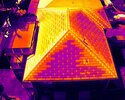It is widely known that utilities are rapidly moving to thermal imaging to detect problems with commercial solar installations. This technology when mounted to a drone can thermal photograph thousands of commercial solar panels in a matter of a few hours and identify bad modules with various issues as well as non-producing strings.
The question is whether this technology could also be applicable for solar roof customers? My initial reaction would be why not, although there are several factors that may make this difficult or impossible.
The reason I bring this topic forward is to potentially provide the homeowner with an alternate method of identifying solar roof issues than having Tesla roll a truck and randomly tear the roof apart until they find the problem. I refer to this as the “needle in a haystack” method. String(s) that are not working can be easily identified. In addition, if there is a single cell that is out on a solar roof module it may continue to function albeit with less output. You may very well have individual solar cells that are not functioning right now and be unaware of it. Thermal imaging can detect this.
Personally, my roof is 21KW and I am almost certain it has issues but have thus far been unable to find anything out of whack.
And lastly, I am not advocating contracting with a commercial drone firm to scan your roof. For most of us it would be cost prohibitive.
Has anyone here ever gone down this path? What are your thoughts?
The question is whether this technology could also be applicable for solar roof customers? My initial reaction would be why not, although there are several factors that may make this difficult or impossible.
- The heat signature as an example on a string that is not working appears cooler than a producing string. This would be an open circuit and thermal imaging hence easily detects this as cooler than a normal panel. The base construction materials are different of a solar roof module which may limit the heat signature.
- The same issue surrounds defective cells within a solar roof module. This typically would be a short which is hotter than normal and may or may not show up with thermal imaging due to the difference in construction material.
- The sunlight must measure at least 600 W/m2 with a solar irradiance meter for valid data. This is easy and quick with a commercial solar farm since panels are typically facing in the same direction. This is not true for residential where there may be several (North, South, East, West) mounting planes. This would require measurements at different times of day to extrapolate valid data for all the solar roof modules.
- Artificial Intelligence (AI) is used to automate the examination of a commercial solar farm. This requires the solar panels be a specific size. Obviously, this could be a potential issue since solar roof modules are radically different in size. They may have to be examined manually which is fine for most residential users.
The reason I bring this topic forward is to potentially provide the homeowner with an alternate method of identifying solar roof issues than having Tesla roll a truck and randomly tear the roof apart until they find the problem. I refer to this as the “needle in a haystack” method. String(s) that are not working can be easily identified. In addition, if there is a single cell that is out on a solar roof module it may continue to function albeit with less output. You may very well have individual solar cells that are not functioning right now and be unaware of it. Thermal imaging can detect this.
Personally, my roof is 21KW and I am almost certain it has issues but have thus far been unable to find anything out of whack.
And lastly, I am not advocating contracting with a commercial drone firm to scan your roof. For most of us it would be cost prohibitive.
Has anyone here ever gone down this path? What are your thoughts?



